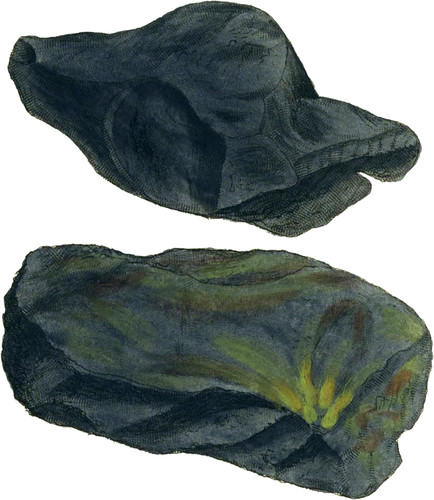 Enlarge
Enlarge
British Mineralogy
Plumbago. Black Lead
- Class 1. Combustibles.
- Order 1. Homogeneous.
- Gen. 6. Carbon.
- Syn.
- Graphites plumbago. Linn. ed. 13. 3. 284.
- Plombagine. De Lisle, 2. 500.
- ————— Carbure de fer. De Born, 2. 395.
- Phlogistiqu saturé de l’acide aérien. Plombagine, Sciagr. 2. 8.
- Graphit. Emmerl. 2. 97.
- Fer minéralisé par le Carbon. Daubenton, 49.
- Carbon combined with one tenth or one eighth of its weight of Metallic Iron. Kirw. 2. 58.
This curious substance, so extensively used by artists of all descriptions, is nowhere found in greater perfection than at Borrowdale near Keswick in Cumberland. It is also found at Crumnock in Ayrshire, and at Kilkenny Well in Ireland, besides some other parts of Europe. That from Borrowdale is made into the finest Black Lead pencils of any in the world, and there is a regular sale of it once a month in London for chat purpose. Jameson says that the finer kinds are first boiled in oil, and then cut into tables or pencils. He is surely mistaken ; and I think a proper examination of the substance in the best pencils is enough to prove it*.
The Plumbago is sold under the title of Black Lead: and the larger lumps, above six inches in length, are bought at 40s. per pound—the middling, from about four inches long, for 35s. per pound: and smaller, about the size of walnuts, are called pints, and sell at 25s. per pound. The buyers or their agents attend and try its goodness by scraping it, always rejecting it when sandy, spongy or powdery; and it is curious to observe the singular shining appearance the examiners make. Sir Joseph Banks generally has a few pencils of the best kind made for himself and a friend, and no art is used to alter the genuine nature of the best Lead. It is, however, said, that there is an art known to one or two pencil-makers, by which they manage the Lead so as to make it as hard as they like. I believe it is pretty well known that the Chalks used in drawing are tempered by the changes from damp to dry, which have a similar effect on Plumbago, it is certainly most generally used without any alteration, and those are most certain of making the best pencils, who have the cunning to choose the most perfect substance. The harder and finer Lead is generally sawn out smallest for the best price, and the coarser sawn out larger for commoner purposes, and is cheaper, exclusive tiff the mixtures made from the dust with Sulphur, Rosin, &c. which are scarcely worth mentioning. This and the more common sort of Lead in dust from various places are used for cleaning stoves†, and for making crucibles, which will bear a strong heat.
Plumbago is mostly found included in mixed rocks—see the next table—in pieces from a grain to 40 or 50 pounds in weight, or larger; there is a piece in the London warehouse of 42 pounds and a half weight, consequently worth 85l.
It has a dull dusty or granular outside, but the least rub or scratch exposes its bright gray metallic lustre. Its fracture is mostly rough and fine, or coarse grained, sometimes rather plated and even foliated. It feels greasy, as it has generally been called, but I submit the word ‘slippery’ to the judgement of the critics. It is, on this account, often used as a preventative to the effects of friction, in preference to soap. It soils, neatly if required, but does not clog. I could never discover it at all crystallized.
The upper figure is from a pure chosen specimen, with which I was favoured by the proprietor of the mine, the Eight Hon. Sir Joseph Banks, Bart.; and an honest pencil-maker, who has attended the sale and seen large quantities for many years, assured me it was of the very best sort. The shape is as cut out for sale, and the colour is perfect, being composed of the substance itself, with the addition of gum water. The substance in question is loo well known to need any more particular mention ; it is, however, necessary to say that Molybdenum much resembles it, but is much brighter, and foliated like Mica, Its specific gravity is from 1.987 to 2.2456.
On analysis it has been found to contain:—
| Carbon or Oxide? of Carbon | 90.9 | or | 90 |
| Iron | 9.1 | or | 10 |
| 100.0 | 100 |
- * We have boiled various fragments in oil, and find them in no way changed:—a red heat softens Plumbago considerably, at the same time it loses 6 or 7 per cent. of its weight.
- † I understand this dust is occasionally adulterated with micaceous Iron—see tab. 64—which is apt to rust, to the great disappointment of the careful housewife, who considers it as the property of the Black-Lead to prevent the Iron from rusting.

